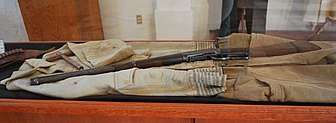Victoriano Ramírez
Victoriano Ramírez López (April 13, 1888 in San Miguel el Alto, Jalisco – March 17, 1929 in Tepatitlan, Jalisco), also known as "El Catorce" (The Fourteen), was a Mexican General of the Cristero War known for his excellent combat skills.
General Victoriano "El Catorce" Ramirez | |
|---|---|
 | |
| Born | Victoriano Ramírez López April 13, 1888 |
| Died | March 17, 1929 (aged 40) |
| Cause of death | Execution or Murder |
| Burial place | Church of Our Lady of Guadalupe, San Miguel El Alto, Jalisco, Mexico |
| Nationality | Mexican |
| Occupation | Cristero General |
| Years active | 1927 - 1929 |
| Spouse(s) | Dolores Gutierrez |
| Partner(s) | Multiple |
| Children | Natalia Ramirez Gutierrez |
| Parents |
|
| Relatives | Francisca Ramirez Lopez (sister) Paulina Ramirez Lopez (sister) Pedro Ramirez Lopez (brother) Vicente Ramirez Lopez (brother) |
Early life

Victoriano Ramirez was born on April 13, 1888, at the Buena Vista ranch in the municipality of San Miguel el Alto to parents Carlos Ramirez and Viviana Lopez, and he had four siblings: sisters Francisca and Paulina, as well as brothers Pedro and Vicente. It was noted that, as a child, Ramirez was very humble and smiled often.
Ramirez, like many children living in the rural areas of Los Altos during the late 19th-century, never attended school. He was never taught to read or write, but his parents taught him how to pray and taught him basic life skills. Victoriano's father, was a farmer, barely making enough money with which to sustain the family, and his mother tended to the household, caring for him and his siblings while educating them on matters such as behavior as well as the Catholic religion, where she instilled in her children a disapproval of Protestants.[1] Ramirez had his first Holy Communion when he was ten years old, almost certainly during the liturgical Easter season in the spring of 1898.[2] During his teenage years, Victoriano was taught how to protect livestock and how to farm.[3]
Adulthood
In the United States
At the age of 20, Ramirez decided to head north to the United States in order to make more money. He arrived in "the north" probably sometime in 1908, and he sent money and letters to his parents back in Jalisco.[4] After a year and a half, Ramirez returned home. Shortly after, his mother, ill and weakened by her age and the absence of her son, died, predeceasing her husband and leaving behind her five grown children.[5]
Alias
Legend holds that once, when he escaped from a prison in San Miguel el Alto, Jalisco where he was waiting for a murder trial after quarrel, a detachment of fourteen armed men went to look for him at a hill. Forced to fight against his pursuers, the fugitive hid among the crags of a ravine and after a long firefight killed all his opponents.[6][7] When he was sure of his victory, he took the field and picked up the fourteen arms of his victims and sent them to the mayor of San Miguel with a message, advising him "not to send such few people", earning him the name "El Catorce" (The Fourteen).[8]
Cristero War
Military success

Ramirez, was among the first to join the Cristero rebellion. He was one of the few Cristeros who did not desert the fight in May of 1927. He commanded the "Fourteen Dragons" squadron, which was part of the San Julian regiment under the command of General Miguel Hernandez. His first acts as a Cristero were spoken of as legendary feats, and tradition goes that when "Callistas" (federal troops) heard the cry of "Viva El Catorce!", it struck fear in their hearts during fighting. Additionally, Ramirez also had a reputation for superb accuracy.[6]
On March 15, 1927 the Battle of San Julian began, and "El Catorce" had to resist a day of federal charges by General Espiridión Rodriguez before General Miguel Hernandez arrived the next day to support him. Eventually, the battle resulted in a Cristero victory, and the federal army suffered their worst defeat in the entire war.[9]
Downfall
The difficulties that arose between Ramirez and his companions began, it seems, with organizational reforms that General Enrique Gorostieta Velarde deemed necessary to establish between contingent Cristeros. Ramirez, perhaps feeling that his authority was being undermined, put a number of obstacles to the proposed new organization. In view of his attitude, he was relieved of his duties, and was banned from having armed men, except for a small escort. Ramirez did not obey these orders, and as he was liked by the people of San Miguel el Alto, they increased his armed escorts. Father Aristeo Pedroza invited him to refocus on the Cristero struggle but Victoriano refused. These refusals antagonized other Cristero leaders, and Aristeo Pedroza, Heriberto Navarrete, and Mario Valdes, eventually pursued Ramirez with 300 men. By then, Ramirez was fortified at the top of El Carretero, along with 100 colleagues.[8]
Death and burial
.jpg)
Ramirez was eventually arrested and accused of embezzlement, insubordination and resistance to higher orders.[8] For these accusations, Father Aristeo Pedroza ordered his execution, and to avoid commotions amongst the Cristeros, as El Catorce was highly esteemed, it was resolved immediately to fulfill the sentence. The details surrounding Ramirez's death are uncertain. One source states that, in order to avoid a popular uproar of the locals in Tepatitlan, Valdes had Ramirez stabbed to death in a discrete manner.[6] Another source states that at the time of his execution, he barricaded himself in his cell, so they had to break down the door with a battering ram to lead him to the place of execution. However, he jumped out with intentions of snatching a rifle of the nearest man, but was mortally wounded by a bullet to the chest.
His remains rest in the Guadalupana catacombs, under the Temple of Our Lady of Guadalupe in the city of San Miguel el Alto.[10]
Personal life
Victoriano Ramirez married Dolores Gutierrez, and the couple had a daughter, Natalia Ramirez Gutierrez.[5] Even though Ramirez as married, he was known to be unfaithful. Locals commented that it was easy to figure out in which ranches you could find "his women". Ramirez and Father Heriberto Navarrete had a conversation, and it is said that the priest was struck by Ramirez's behavior and asked him the name of his legitimate wife, to which he replied: "Any woman is legitimate".[9]
Legacy
At hearing about Ramirez's death, the Mexican Army General Saturnino Cedillo said, "El Catorce was killed by his own comrades, idiots! They don't realize what they did. They cut the head of the snake, and left the tail to me". The death of "El Catorce" generated confrontations between General Miguel Hernandez and General Enrique Gorostieta Velarde as well as an extremely negative reaction from the local population, which had held Ramirez with high regard.
In popular culture
El Catorce was portrayed by actor Oscar Isaac in the film Cristiada (also titled For Greater Glory), an epic historical drama also starring Andy Garcia, Eva Longoria, Eduardo Verástegui and Peter O'Toole. In the film El Catorce meets a much more heroic end.[11]
References
- Hernández Hurtado, Juan Francisco (2014-06-27), "Capítulo I. La pobreza del Niño Victoriano", ¡Tierra de cristeros! : Historia de Victoriano Ramírez y de la revolución cristera en los altos de Jalisco, Historia, Centro de estudios mexicanos y centroamericanos, pp. 35–36, ISBN 978-2-8218-4610-4, retrieved 2020-04-05
- Hernández Hurtado, Juan Francisco (2014-06-27), "Capítulo II. Camino a Sn. Miguel", ¡Tierra de cristeros! : Historia de Victoriano Ramírez y de la revolución cristera en los altos de Jalisco, Historia, Centro de estudios mexicanos y centroamericanos, pp. 37–38, ISBN 978-2-8218-4610-4, retrieved 2020-04-05
- Hernández Hurtado, Juan Francisco (2014-06-27), "Capítulo IV. De guardián a labrador", ¡Tierra de cristeros! : Historia de Victoriano Ramírez y de la revolución cristera en los altos de Jalisco, Historia, Centro de estudios mexicanos y centroamericanos, pp. 41–42, ISBN 978-2-8218-4610-4, retrieved 2020-04-05
- Hernández Hurtado, Juan Francisco (2014-06-27), "Capítulo V. Aventuras y sufrimientos", ¡Tierra de cristeros! : Historia de Victoriano Ramírez y de la revolución cristera en los altos de Jalisco, Historia, Centro de estudios mexicanos y centroamericanos, pp. 43–45, ISBN 978-2-8218-4610-4, retrieved 2020-04-05
- Hernández Hurtado, Juan Francisco (2014-06-27), "Capítulo VI. De regrezo a su tierra natal", ¡Tierra de cristeros! : Historia de Victoriano Ramírez y de la revolución cristera en los altos de Jalisco, Historia, Centro de estudios mexicanos y centroamericanos, pp. 46–47, ISBN 978-2-8218-4610-4, retrieved 2020-04-05
- Hernández Hurtado, Juan Francisco (2014-06-27), "Capítulo XXVI. Muerte de Victoriano en el Pcio de Tepa", ¡Tierra de cristeros! : Historia de Victoriano Ramírez y de la revolución cristera en los altos de Jalisco, Historia, Centro de estudios mexicanos y centroamericanos, pp. 140–145, ISBN 978-2-8218-4610-4, retrieved 2020-04-05
- Jowett, Philip (2019-08-22). Liberty or Death: Latin American Conflicts, 1900–70. Bloomsbury Publishing. ISBN 978-1-4728-3354-9.
- www.monografias.com https://www.monografias.com/docs/Biografia-de-Victoriano-Ramirez-P3DXY6ZBY. Retrieved 2020-04-05. Missing or empty
|title=(help) - "Victoriano Ramírez "El Catorce" Comandante Cristero | | Travel-Leon.Net: León, Guanajuato" (in Spanish). Retrieved 2020-04-10.
- "Gen Victoriano "El Catorce" Ramírez". Find A Grave. Retrieved 15 February 2020.
- For Greater Glory: The True Story of Cristiada (2012) - IMDb, retrieved 2020-04-10